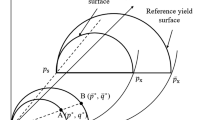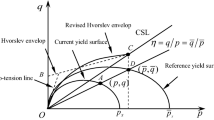Abstract
On the basis of a double hardening model for clays and available experimental results, a new thermo-elasto-plastic constitutive model for saturated clays is proposed to describe the effects of temperature and overconsolidation ratio on the mechanical properties of saturated clays. Two hardening parameters are introduced: \( {\sigma}_{{\rm c}}^{\prime}\) and α. The proposed model is then applied to simulate the relevant important features of saturated clays with different overconsolidation ratios under different temperature and loading conditions. The model predictions are compared with available experimental results to demonstrate its accuracy and usefulness.





Similar content being viewed by others
References
Abuel-Naga HM, Bergado DT, Chaiprakaikeow S (2006) Innovative thermal technique for enhancing the performance of prefabricated vertical drain during the preloading process. Geotext Geomemb 24:359–370
Baldi G, Hueckel T, Pellegrini R (1988) Thermal volume changes of the mineral-water system in low-porosity clay soils. Can Geotech J 25:807–825
Burghignoli A, Desideri A, Miliziano S (2000) A laboratory study on the thermo-mechanical behavior of clayey soils. Can Geotech J 37:764–780
Cekerevac C, Laloui L (2004) Experimental study of thermal effects on the mechanical behavior of a clay. Int J Numer Anal Methods Geomech 28:209–228
Cui YJ, Sultan N, Delage P (2000) A thermo-mechanical model for saturated clays. Can Geotech J 37:607–620
Graham J, Tanaka N, Crilly T, Alfaro M (2001) Modified Cam-clay modeling of temperature effects in clays. Can Geotech J 38:608–621
Hueckel T, Borsetto M (1990) Thermo-plasticity of saturated soils and shales: Constitutive Equations. J Geotech Eng 12:1765–1777
Hueckel T, Baldi G (1990) Thermo-plasticity of saturated clays: experimental constitutive study. J Geotech Eng 12:1778–1796
Hueckel T, Pellegrini R, Olmo CD (1998) A constitutive study of thermo-elasto-plasticity of carbonatic clays. Int J Numer Anal Methods Geomech 22:549–574
Laloui L, Cekerevac C, Vulliet L (2001) Thermo-mechanical modeling of the behaviour of MC clay. In: Desai CS (ed) Computer methods and advances in geomechanics. Balkema, Rotterdam, pp 829–835
Laloui L, Cekerevac C (2003) Thermo-plasticity of clays: an isotropic yield mechanism. Comput Geotech 30:649–660
Lingnau BE,Graham J,Tanaka N (1995) Isothermal modeling of sand-bentonite mixtures at elevated temperature. Can Geotech J 32:78–88
Modaressi H, Laloui L (1997) A thermo-viscoplastic constitutive model for clays. Int J Numer Anal Methods Geomech 21:313–335
Shen ZJ (1995) A double hardening model for clays. Rock Soil Mech 16(1):1–8 (in Chinese with English abstract)
Sultan N, Delage P, Cui YJ (2002) Temperature effects on the volume change behavior of Boom clay. Eng Geol 64:135–145
Tanaka N, Graham J, Crilly T (1997) Stress–strain behavior of reconstituted illitic clay at different temperatures. Eng Geol 47:339–350
Xing HL, Makinouchi A, Mora P (2007) Finite element modeling of interacting fault system. Phys Earth Planet Inter 163:106–121
Xing HL, Makinouchi A (2002) Three dimensional finite element modelling of thermomechanical frictional contact between finite deformation bodies using R-minimum strategy. Comput Methods Appl Mech Eng 191:4193–4214
Author information
Authors and Affiliations
Corresponding author
Rights and permissions
About this article
Cite this article
Liu, E.L., Xing, H.L. A double hardening thermo-mechanical constitutive model for overconsolidated clays. Acta Geotech. 4, 1–6 (2009). https://doi.org/10.1007/s11440-008-0053-4
Received:
Accepted:
Published:
Issue Date:
DOI: https://doi.org/10.1007/s11440-008-0053-4




